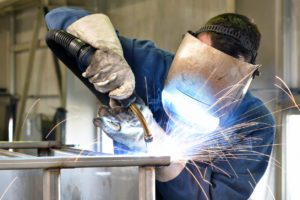










Have you been injured in a welding accident in Boston, MA? Are you wondering whether you can recover compensation for your injuries, lost income, and other damages? If so, the Boston welding accident lawyers of Sweeney Merrigan Law, LLP, can help.
We understand the financial hardship caused when a person is injured in an accident. Our legal team fights to get you the money you deserve as quickly as possible so that you can continue to heal and recover.
Put our 100 years of combined legal experience to work for you. Call our office at (617)-391-9001 to schedule a free consultation with one of our Boston construction accident lawyers.

Being injured in an accident can be an overwhelming experience. How are you going to pay your bills? Who pays for your medical treatment?
Having an experienced Boston personal injury attorney handling your case can reduce your stress and anxiety.
Your lawyer handles all aspects of your case. You can focus on what is important – your health and your family.
When you hire our legal team, you can expect us to:
Our Boston personal injury attorneys are passionate about fighting for the rights of accident victims. We aggressively pursue all causes of action to maximize your recovery for an accident case. Our legal team has recovered numerous multi-million dollar awards for clients.
Get the help you need from attorneys who have dedicated 100 combined years to fighting for accident victims and their families.
Reach out to our law office now to schedule your free consultation with a Boston welding accident lawyer.
Welding is a challenging trade that requires substantial training to master. Unfortunately, many trained welders sustain injuries each year, even though they diligently follow safety procedures.
Welding joins two pieces of metal using intense heat to liquefy the medal. Because of dangerous levels of heat, welding can be a very dangerous job. Welders are exposed to ultraviolet radiation, metal fumes, and intense heat.
Whether on a construction site or a welding shop, welding work can be challenging and dangerous.

Welders must exercise a high level of care to avoid injuries from welding accidents.
A variety of circumstances can lead to a welding accident.
Some factors that might contribute to a welding injury include:
Employees and employers must take precautions to avoid welding accidents and exposure to dangerous and hazardous conditions while welding.

The dangers and hazards faced by welders can result in life-threatening injuries and conditions.
Welding accidents can cause permanent impairments and disabilities.
Common welding injuries include, but are not limited to:
Some welding injuries can be treated for a full recovery. However, there are some cases in which a welder sustains permanent impairments or disabilities. In the most severe cases, a welder may sustain life-threatening injuries that result in wrongful death.

If the welding injury occurred on the job, the welder’s injuries might be covered by workers’ compensation insurance. However, a welder may also have a third-party claim regarding a welding injury.
For example, if the welding equipment was defective, the welder might have a product liability claim against the manufacturer.
If a dangerous or hazardous condition existed on the property that caused the welding accident, the welder might have a premises liability claim against the property owner.
Identifying each of the parties and causes of action that could result in compensation for your damages is a crucial step in the personal injury claims process.
Damages from a welding accident could be substantial. The medical bills and lost wages could total hundreds of thousands of dollars before you include compensation for pain and suffering damages.
Our Boston workplace accident lawyers do not stop investigating and fighting for your rights until we exhaust all avenues of compensation for your welding injury case.
Having a law firm with the resources, skills, experience, and time to investigate and pursue an injury claim working for you evens the playing field. Do not fight a large corporation, aggressive insurance company, or the workers’ compensation carrier alone. Let us take up the fight for you so that you can focus on healing.
Call Sweeney Merrigan Law, LLP today to schedule your free consultation with a Boston welding accident attorney.
Attorneys at Sweeney Merrigan Law, LLP have been recognized and honored by several of the top legal associations, including SuperLawyers, National Trial Lawyers Association, and Best Lawyers.
Sweeney Merrigan Law, LLP is a highly successful personal injury law firm serving Massachusetts since 2011.
There are no fees or costs unless we win your case!
We use cookies on our site to analyze traffic, enchance your experience, and provide you with tailored content.
For full functionality of this site, you must consent to the use of cookies. For more information or to opt out, visit our privacy policy